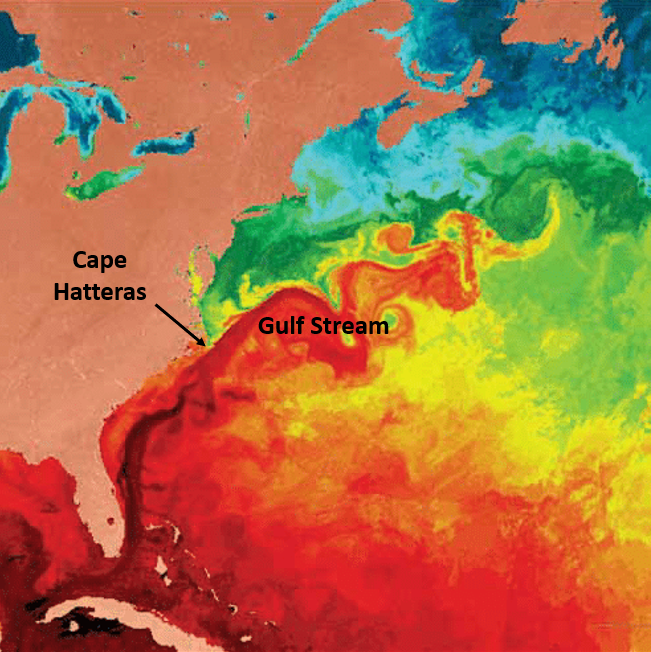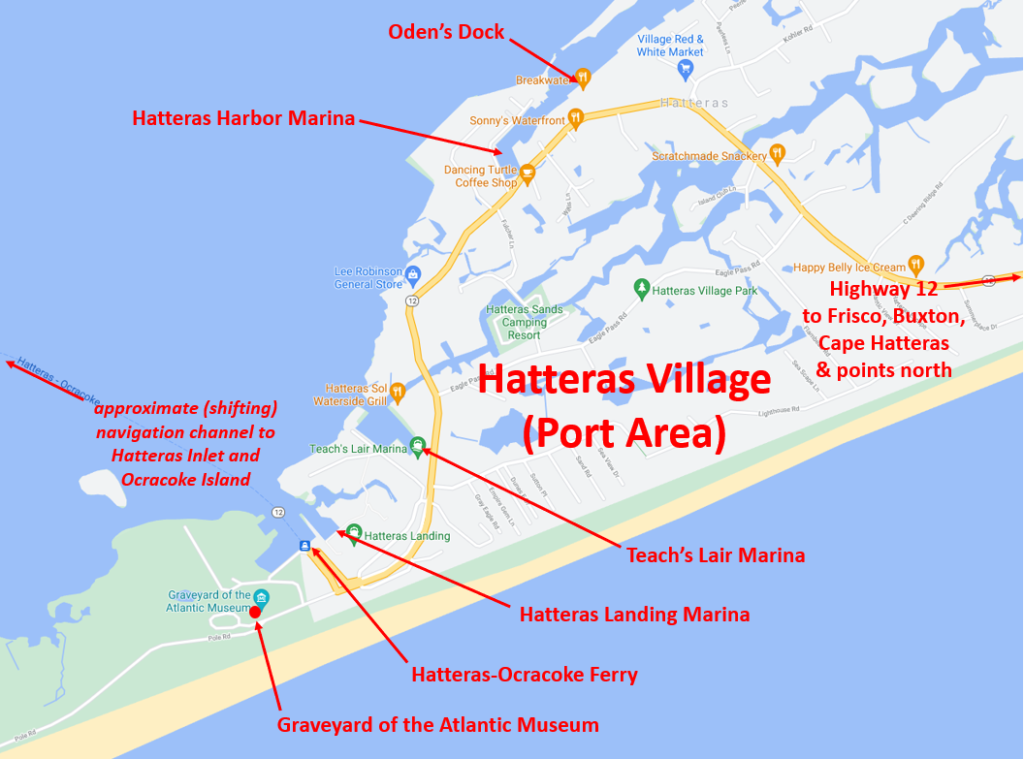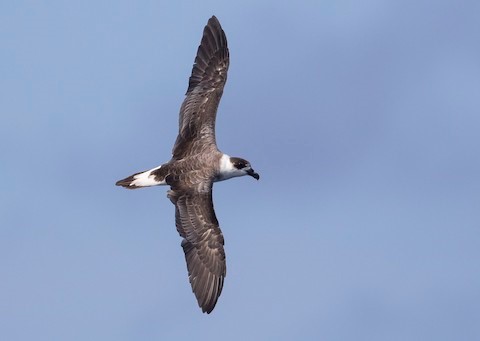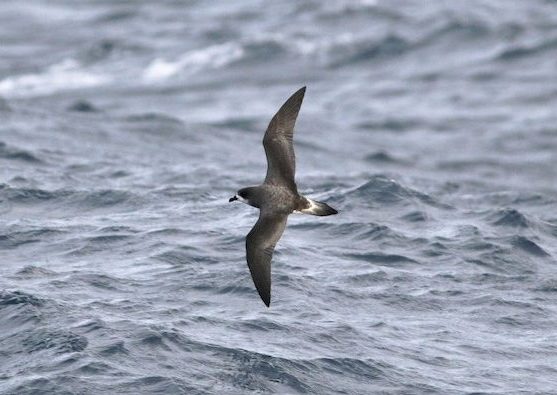Hatteras, North Carolina (Offshore Waters)

In eastern North America, the offshore waters of Cape Hatteras are unparalleled for access to pelagic bird diversity. It is a short trip from port to the continental shelf edge, to an area that is especially productive because it is the mixing zone for warm Gulf Stream waters and the southernmost tongue of the cold Labrador Current. Sixteen species of tubenoses occur regularly: four Pterodroma petrels (Black-capped, Trindade, Desertas a.k.a. Fea’s, and Bermuda); Northern Fulmar; six shearwaters; and five storm-petrels. Other seabirds seen regularly include Catesby’s and Red-billed Tropicbirds, Bridled and Sooty Terns, all three jaegers, and Great and South Polar Skuas.
Orientation
Directions
The port of Hatteras is at the end of the road (NC Highway 12) on North Carolina’s Outer Banks, near the southern tip of Hatteras Island, about an hour and 20 minutes’ drive (62 miles) south of Nags Head, three hours (140 miles) south of Norfolk, Virginia, and six hours (340 miles) south of Washington, D.C.
The only regular operator of pelagic birdwatching trips out of Hatteras is Brian Patteson, whose boat, the Stormy Petrel II, departs from Hatteras Landing Marina. This is the last parking lot before the terminal for ferries to Ocracoke Island.
Follow Highway 12 south past Teach’s Lair Marina, then turn right at the sign “Villas at Hatteras Landing.” After passing the Villas, proceed to the second entrance to the parking lot, and park on the southeastern side of the lot, in the spaces that face toward the ferry loading area.
Attractions
Cape Hatteras is approximately 12 miles east of Hatteras Village (the port). The headquarters of the national seashore is beside the iconic lighthouse and a few miles from the most seaward projection of the Outer Banks: Cape Point.
Birdfinding
The offshore waters of Hatteras are dynamic, as the Gulf Stream meanders and unseen currents interact below the surface, while above weather conditions are rarely static for long. The variability of conditions and tension of competing currents make Hatteras pelagic trips more diverse overall than trips out of other ports in eastern North America.
Seasonal timing is the only factor under a visitor’s control, and it is the main determinant of which birds can be expected or considered reasonable possibilities. Hatteras trips are organized according to four “seasons” (which have the same names but differ from the familiar seasons) based on historical patterns of bird occurrence.
Winter trips are usually in February, sometimes in March.
Spring typically refers to late May and early June (a brief, busy span with a reputation for producing the most diverse and interesting assortments of species).
Summer trips run infrequently between mid-June and late August.
Fall trips are concentrated in September and October, rarely into November.

Satellite image of sea surface temperature showing the Gulf Stream and large rings and eddies. (Talley 2000) Note the strategic position of Cape Hatteras, where the Gulf Stream first meets the southernmost extension of a cooler coastal current.

The following species are annual, or at least fairly regular, in Hatteras offshore waters:
Catesby’s Tropicbird: rare May-August
Red-billed Tropicbird: rare May-August
Wilson’s Storm-Petrel: common May-October
White-faced Storm-Petrel: very rare July-August
Band-rumped Storm-Petrel: common May-August
European Storm-Petrel: very rare May-June
Leach’s Storm-Petrel: fairly common May-August
Northern Fulmar: common in winter, rare in October
Trindade Petrel: uncommon May-August
Black-capped Petrel: common year-round
Bermuda Petrel: very rare May-August
Desertas Petrel: uncommon May-June, then rare to September
Great Shearwater: common May-October
Sooty Shearwater: common May-June, uncommon August-September
Cory’s Shearwater: common May-October
Scopoli’s Shearwater: uncommon May-October
Manx Shearwater: uncommon year-round
Audubon’s Shearwater: common year-round
Northern Gannet: common in winter, uncommon May-June and October
Brown Booby: very rare June-August
Masked Booby: very rare May-October
Red-necked Phalarope: common May-June and again late July-October
Red Phalarope: common in winter, rare in May and August-October
Parasitic Jaeger: fairly common May-June and August-October
Long-tailed Jaeger: fairly common May-June and August-September; uncommon in July
Pomarine Jaeger: common May-November, uncommon in winter
Great Skua: fairly common in winter
South Polar Skua: fairly common May-October
Atlantic Puffin: uncommon in winter
Thick-billed Murre: very rare in winter
Common Murre: very rare in winter
Dovekie: fairly common in winter
Razorbill: fairly common in winter
Sooty Tern: rare May-June; fairly common July-September
Bridled Tern: fairly common May-September
Black-legged Kittiwake: fairly common in winter
Sabine’s Gull: uncommon in September

The following have been seen in Hatteras offshore waters, but are not known to occur regularly:
Atlantic Yellow-nosed Albatross: February 22, 2014
Black-browed Albatross: February 18, 2012
Black-bellied Storm-Petrel: three records, June-August
Swinhoe’s Storm-Petrel: three records, June-August
Zino’s Petrel: September 16, 1995
Cape Verde Petrel: hypothetical, with a few likely records in May and June
Tahiti Petrel: May 29, 2018
Wedge-tailed Shearwater: May 22, 2021
Cape Verde Shearwater: August 15, 2004
Magnificent Frigatebird: three records, May-August
Brown Noddy: five records, May-August
Services
Accommodations
In Hatteras Village, close to the dock:
Breakwater Inn, 1-252-986-2565
Sea Gull Motel, 1-252-986-2550
Village Motel, 1-252-986-2522
Villas of Hatteras Landing, 1-252-986-1110 (suites with kitchens)
In Buxton, about 20-30 minutes’ drive (10-12 miles) away:
Cape Pines Motel, 1-252-995-5666
Cape Hatteras Motel, 1-252-995-5611
Hatteras Island Inn, 1-252-995-6100
Lighthouse View Motel, 1-252-995-5680
Outer Banks Motel, 1-252-995-5601
Notes
When to Visit
The mini-season generally regarded as the peak for seabird diversity and maximum potential for rarities is the “spring” (especially the last week of May and first week of June), with Memorial Day weekend traditionally favored. Other times of year can also be productive: differing selections of species are typically found in winter (February-March), summer (July-August), and fall (September-October).
Hazards & Hassles
As with any other offshore boatride, visitors should prepare for a wide range of conditions by bringing: multiple layers of clothing (including an outer layer suitable for rain or seaspray), soft-soled shoes, sunscreen, sunglasses, and their favored seasickness prophylaxis.
Links



